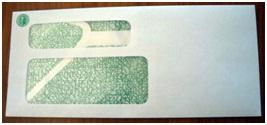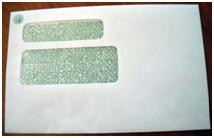State Document and Mailing Standards
We outline document and mailing standards for all state agencies to reduce mailing costs, simplify mail processes, and improve mail quality and tracking.
State document and mailing standards apply to:
- Address format
- Document layout
- Barcodes guiding the inserting equipment
- Mail type
- Envelopes carrying the material.
- Letter (#10 window envelope)
- Flat (9x12 or 10x15 window envelope)
Standard components help reduce the cost of operations and lower our carbon footprint.
Document layout for automated inserting and presorting
The first stage of any mailing is creating the documents to mail. Use the state standard document template to:
- Design the cover or main page of your mail
- Identify the proper intelligent insert barcode type and placement
- Use State Standard Envelopes
- This ensures your letters can receive a presorted postage discount.
Outer Envelopes
The best way to streamline the insert process is to use a State Standard dual window envelope. We offer:
- #10 (normal letter size)
- 6” x 9.5” letter
- 9” x 12” flat
- 10” x 15” flat
Insert jobs can use these envelopes if your document fits our easy format guidelines. There is no need to order and store envelopes when you use a State Standard Envelope.


How does this service contribute to savings goals?
- We take advantage of volume pricing and pass the savings to you.
- We add the envelope cost to your inserting job cost and include it in your monthly invoice.
- You do not need to order or store envelopes for qualifying inserting jobs.
- We practice sustainability efforts by reducing waste and transportation.
- We maintain a supply of envelopes, reducing the potential for delays.
- Our envelopes accommodate a wide range of state mailings for postage discounts.
Other mailing standards to consider
- Tabbing
- Used for self-mailers.
- See the tabbing guidelines for the recommended tab placement.
- Recommended paper weights
- Postcards: 75 lb cardstock, non-glossy
- Self-mailers: 28 lb paper, non-glossy
- Inserts (for automated equipment): 28 lb paper, non-glossy
- Folding
- Self-mailers and inserts, “C” folds are required with the fold at the bottom.
- Ink jet file format (Excel file)
- Use this for your address list.
- Delivery address specifications
- The USPS has guidelines for formatting delivery addresses.
- Postal regulation regarding window envelopes requirements
- Mail in windowed envelopes must meet USPS requirements, such as the "tap test."
- Insert integrity and barcodes
- Use these tips to choose the right integrity level for your mail.